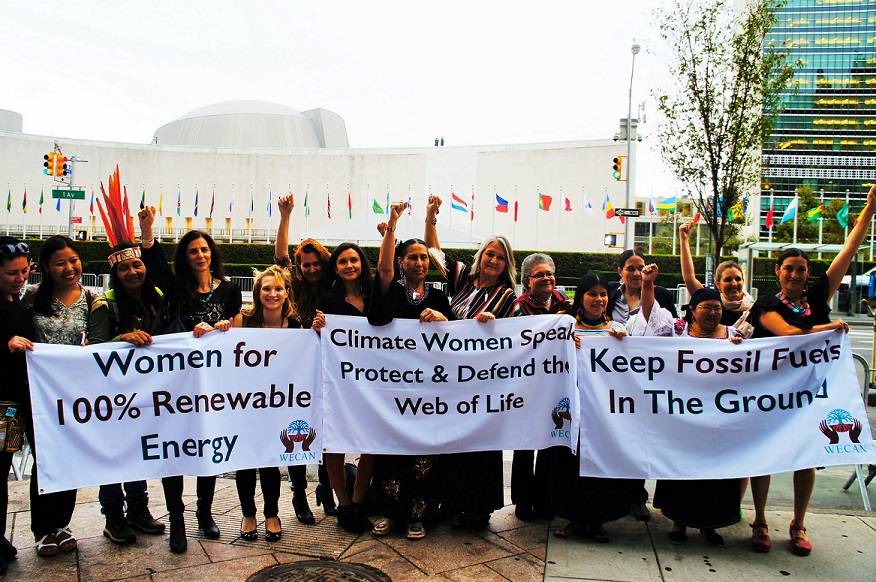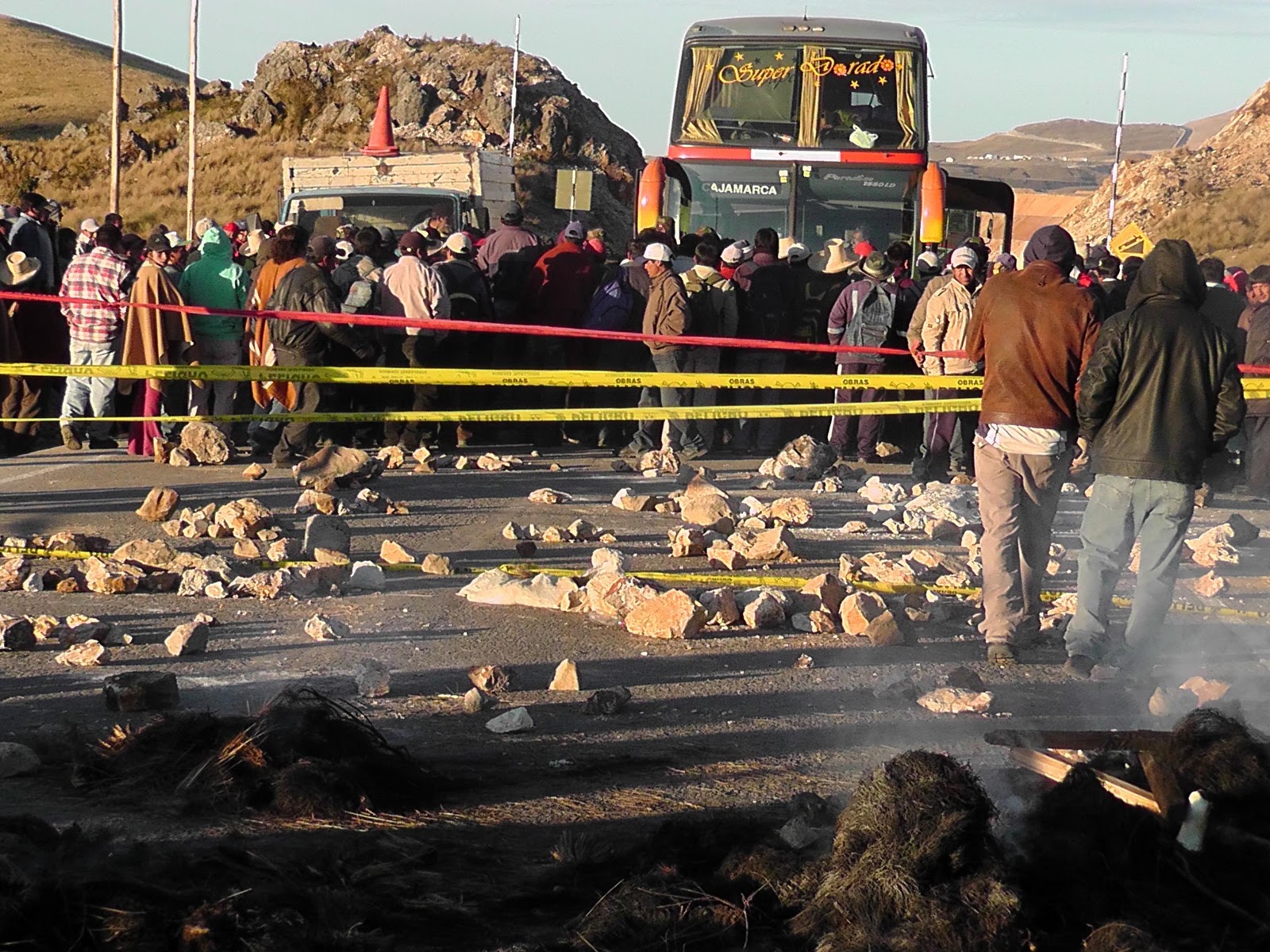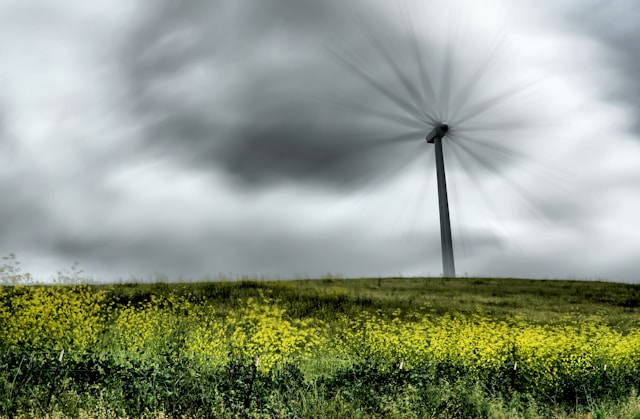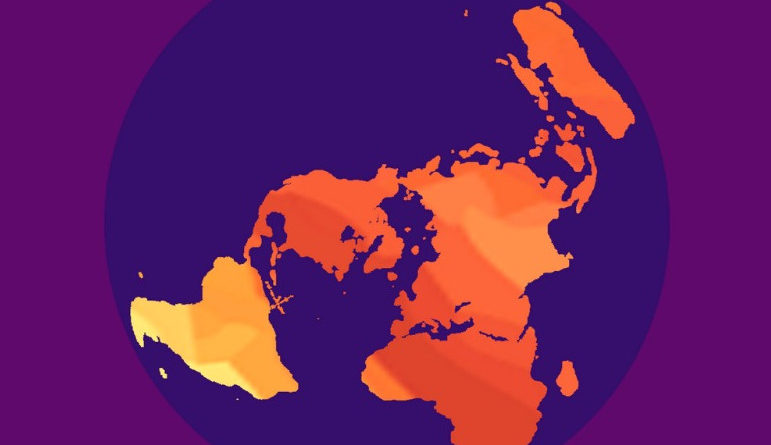
Ending systems of domination: Reclaiming our bodies and politics from global trauma
The article was first published on the Radical Ecological Democracy website. on 10/24/2021. Article link.
Ending systems of domination: Reclaiming our bodies and politics from global trauma
By Eva Schonveld and Justin Kenrick
As the sun goes down on a system that cannot save us from itself, our only option is to bring that system to an end. But what is that system, and how do we replace it?
We begin from the understanding that systems of domination are, both, inside and between us, and that transforming social and political relations starts as much from our hearts and the personal as from the predicament of the earth, and all our societal relations. We begin from Scotland where we live, and where COP26 will yet again make grand promises but do nothing to stop us all hurtling off the climate cliff edge.
Colonization’s torment continues
Scotland has been both colonized and colonizer. Without the history of colonization of Scotland and England, there would have been no British Empire colonizing overseas. Without the vicious clearing of highland communities from their lands here, there would not have been the families desperate for food and a future, with no choice but to work for a pittance in the factories and furnaces of empire, or to fight its wars.

The mass murder wreaked by empire, the evisceration of others’ cultures and stealing of their lands, and the forced residential schooling of the youth, has viciously harmed indigenous peoples in the Americas, Asia, Africa and Australasia, while being dressed up as a ‘civilizing mission’ or ‘progress’. The same is true of how this system treats the vast majority of those living precariously in the British Isles, who are told that they benefit from a system that blames them for the inequality they suffer. But do even the 1% who supposedly benefit, really benefit? Those whose empathy is broken through the boarding school system, and whose shallowness is groomed by a compliant fawning media perpetuating its life-destroying feudal, corporate and political world?
Finding a way through
It is not by chance that our system is stumbling us into extinction.
We need to find new ways to gather, to make decisions, to organize, and to take responsibility for each other, so that we can respect and nourish all life, since those tasked with this responsibility have so disastrously and inevitably failed, since the dominant system’s purpose is not to respect and nourish but to control, co-opt and exploit.
We also need to re-imagine how we rediscover, create and maintain the enduring or emergent alternatives. Too often they unintentionally include (or fail to challenge) assumptions based on our dominant lived experience of (mostly) patriarchal, racist, hierarchical cultures. The growing understanding of personal and cultural trauma – its ubiquity, its unconscious nature, its debilitating effects, and, most crucially, our ability to learn and heal from it, provide radical possibilities for uncovering and shifting those unconscious (traumatized) assumptions and for (re)discovering genuinely fresh and emancipatory ways of being and working together.
Understanding trauma
Trauma is a complex neurological process, but in brief it is the way our mind deals with events, which we experience as physically or emotionally overwhelming. These are not stored as memories, but are patterned into the nervous system: the unconscious: the body. These patterns can be ‘triggered’ when we are reminded of the initial experience. Because this triggering happens instantaneously and unconsciously, we rarely even notice that we have been plunged into an emotional state which now has little to do with what’s going on in the present.
We all accumulate some level of trauma during our childhood. This can show up in adulthood in disparate areas of life, for example public speaking, standing up for ourselves, managing our anger or coping with rejection, where we know we tend to act differently to how we would like. Dig a little into these uncomfortable feelings and the roots always lead back to childhood within a dominating system. Every one of us experiences our own versions of this, but the underlying reasons are rarely acknowledged. The socially condoned view is that because we largely forget them, these early experiences are over. In fact, unaddressed, they continue to shape our lives.

Imperialism, colonization, supremacy, stratification, capitalism… these are culture level traumas: legacies of past damage that continue to re-inflict it. They play out in the world in many forms: in the stratifications of class or caste, sexism and racism, in economic inequality, wars, biodiversity loss, climate change… and as with personal trauma, the root causes of our cultural traumas are obscured, making what are essentially breaks with reality seem absolutely normal and inevitable, at least to those experiencing it.
Power and society
This system of domination also lives inside of us, within our bodies, our emotions, our relationships, our attitudes, our social structures, the way we act towards those we see as different to ourselves, other species and the wider natural world. We can see it in the way we bring up our kids, in our family and work relationships, and also in our health, education, economic, and political systems.
The casualties of power by domination include those currently at its apex, many of whom have been through a traditional ruling class upbringing of distant or proxy parenting, separation, physical punishment and/or emotional denial combined with treats and rewards, sometimes with visibly crippling results, but intended to result in the smooth, controlled and controlling presentation of the elite. These child-rearing practices are designed to cauterize empathy in the next generation of the ruling class. This vicious cycle of unacknowledged intergenerational personal and cultural trauma, combined with a hereditary system of domination turbo charged by the neoliberal agenda over the past 40 years, is now running close to costing us everything.
Wherever any of us experience or perpetrate domination, it is traumatic and traumatizing. Our personhood, our capacity for loving connection, our innate health are defiled and traumatized by this system. The implications of this collective blind spot for our capacity to create collaborative, rather than dominating, cultures and social infrastructure is monumental: if we can’t name it, we can’t change it.
But at the same time as all this, that innate health (both personally and collectively) is still alive, active and accessible to us. And this is where hope lies. If we address the root cause of our problems – we may even yet be able to change some of our outcomes.
Changing the power dynamic
Given the rapid unraveling of the natural systems that all us living beings depend on to survive, only the deepest of change is enough. We don’t need system change, if that means some changes to this system. We need to turn the dominating system into compost that can nourish the living systems we are. Carbon emissions have never been the real problem; they are simply a consequence of the fact that our system leaves us too traumatized to act rationally, even in the face of possible extinction.
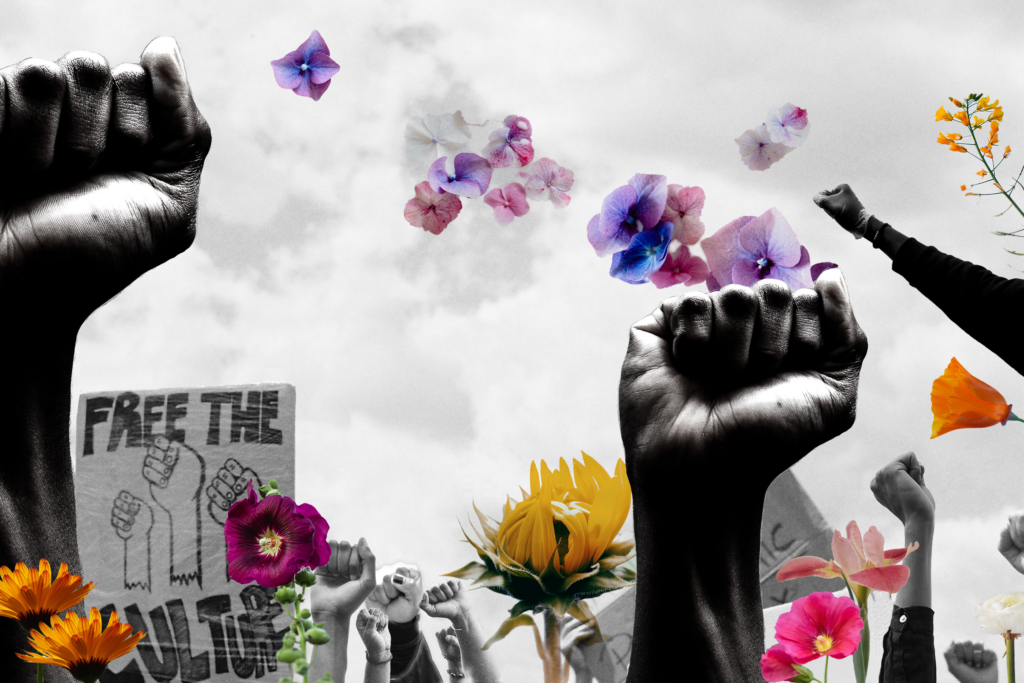
Personal and collective inner work is needed to unpick the systems of domination that play out in our bodies and psyches, in our personal and work relationships, in our organizations, our social systems, our relationships across cultures and with other species and ecosystems. Doing this difficult, often painful work is the only viable way out of this mess. Luckily, it is also the work of healing and liberation. It takes courage and determination to start, and it is not easy, but once we have begun it is a movement towards health and wholeness that brings with it increasing capacity for connection, pleasure, love and joy.
From shaming to learning
It is impossible to transform toxic power relations without venturing into the emotional realm. Without understanding and working to heal the unconscious drivers, which suppress our empathy, we inevitably end up disempowering others and ourselves, and often unintentionally replicate that which we are trying to change.
None of this is socially acceptable!
In dominating cultures we laugh at and judge harshly people who show their care too clearly – those who go to therapy (screw-ups), who show vulnerability (failures), who take care with language (politically correct) who work for the environment (tree huggers), who protest and get arrested (attention-seeking privileged, or dirty criminals), who dance (hippies), who cry (embarrassing), who try to make a difference (do-gooders).
Standing up to this can be tough, but we can support one another and know that the fact that we feel such social censure is a good indication that we’re successfully challenging the system. Transforming attempts to shame us into opportunities to learn more about the system we need to change is core to this work. We (collectively) need to be doing this work at every level: in ourselves and our relationships, in our families, in our workplaces, in our professions, in the way we do politics, education, healthcare, nature-care, but we also need to be sure that the changes we are making are genuinely coming from a different root and will give us different results.
Resisting, and trusting our guts
Much of the cultural genocide practiced during the (ongoing) colonial period was and is done by people convinced that they are acting well: freeing others from ignorance and ungodliness, bringing health, education and democracy, stimulating new markets.
So how can we tell what change is genuinely helpful?
There are no road maps, but there are processes and practices that can help guide us. Understanding how trauma works, and how to process and heal it is crucial. We know how to work with trauma in the personal mind-body. Working with trauma in our social and cultural systems is not all that different: what we know works in personal therapeutic processes we can apply out in the world.
We can bring curiosity, tenacity, compassion, generosity, sensitivity, honesty, courage, spaciousness and patience. We can look at the history and the painful triggers together. We can express and unwind our hurt, shame and loss together. We can open our hearts, practice mindfully, use our imaginations and our creativity to build new ways of doing things (pretty much everything), get comfortable with making mistakes (and learning from them), with not knowing, with showing our vulnerability, and also with showing the strength of our care.
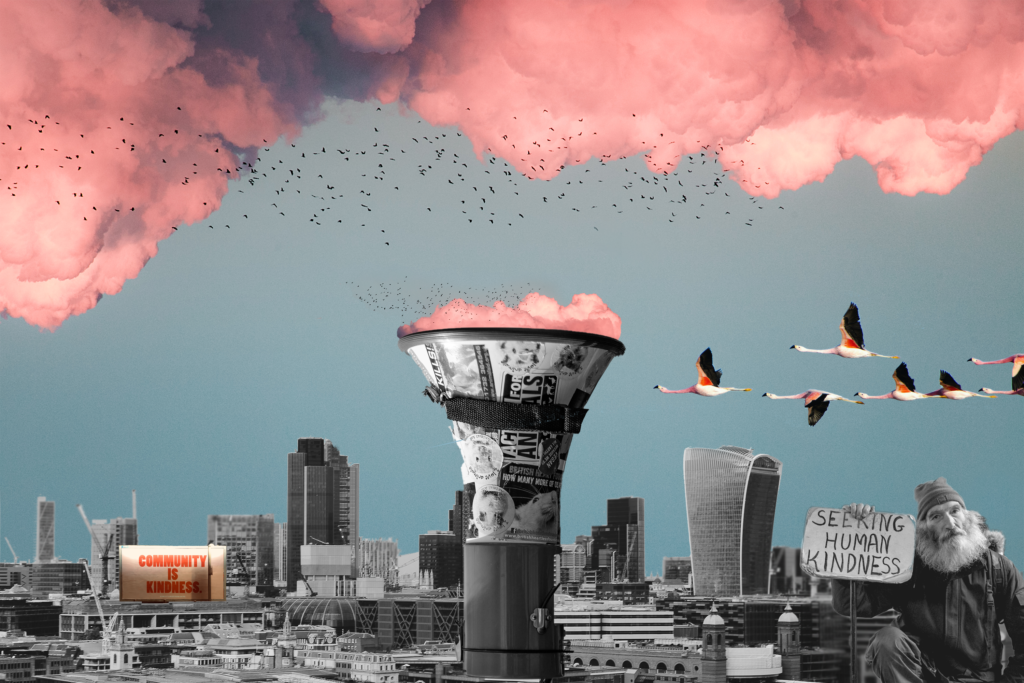
We don’t have to shrink from hard truths. We can make a stand when we see domination in action, we can pay attention to and resist the old patterning, and we can pick ourselves up over and over again as we inevitably fail. We can apologize, make reparations. We can forgive, build relationship across all kinds of perceived differences, prioritize connection over performance, treasure the local, challenge the global, center the earth, and learn how to trust our collective guts.
We need to resist the cultural programming that says there’s nothing we can do, that those in power know best, that genuine social change is a myth. Let’s resist it by proving it wrong: facing our fears and doing it anyway. Let’s take whatever first small, wise steps we need to towards creating a world where we know and act on the truth that our well- being depends on ensuring the well-being of others, not on exploiting them.
We can’t now stop the reckoning that’s underway. We can only wake up, take responsibility, get over our egos and start working together for our collective, planetary healing. This is the ONLY work that matters now. We don’t necessarily need to change what we are doing. We simply need to do it with this in mind/ heart, in community/ society, in relationship with all.
The Sunset assembly
As the sun goes down on the 29th of October, a unique assembly will begin. It will continue for 24 hours, following the sunset around the world, passed from community to community.
Community members will speak and listen to one another from the heart. Each community will use different forms of meeting, as we collectively seek a path towards a politics of wholeness where our decisions are based on being deeply present to each other, rather than speaking at each other. Our common focus is on:
“How the system is impacting on me and my community, and how we are resisting, creating alternatives and maintaining connectedness in the face of it”
The timing is no coincidence: COP26 starts on 1st November and will be no different to the previous 25. The Climate COPs are mind-bogglingly successful at pretending they are tackling the climate crisis, while enabling the fossil fuel industry to receive billions in subsidies, emissions to rise exponentially, and corporate interests to perpetually delay real action.
Grassroots to Global, which has sparked this assembly, is working to build alternatives to our current collective decision making processes. Most of what democracy we have has been wrung from the hands of those with power who have given up only the absolute minimum amount of power they have had to in order to stay in power – most often followed by their rapidly retracting the real power to decide.
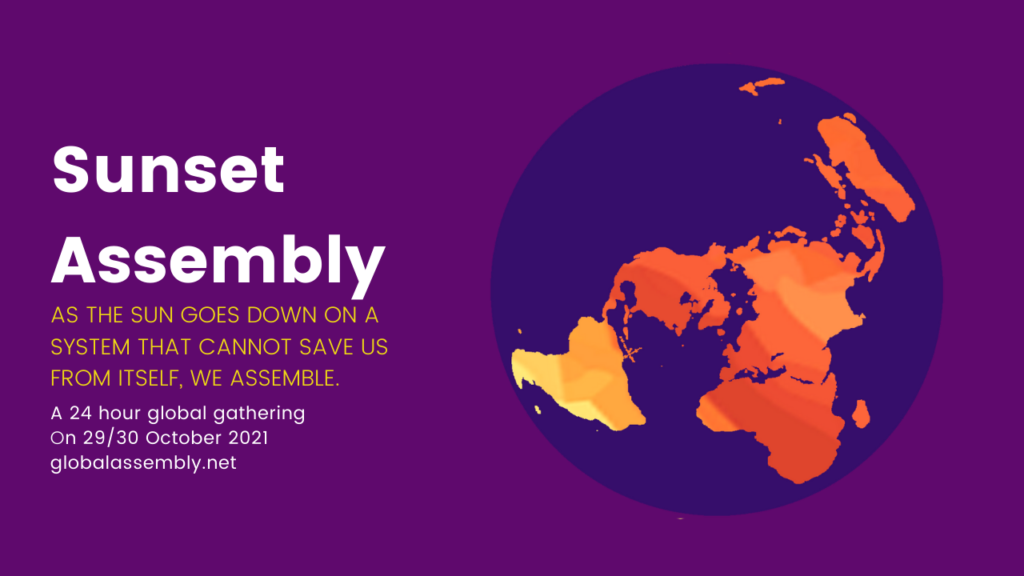
We need to rediscover enduring – and explore emerging – ways to gather, to deliberate and to decide together – developing a ‘relational democracy’ that can deepen and replace an easily captured ‘representational democracy’, and that can prevent democracies from sliding into outright authoritarianism.
Enabling the future
This is an ongoing area of exploration (you can read early thinking on that here and here) and will continue to develop as we learn through processes like Reworlding and the Sunset Assembly. Some essential elements of such relational decision-making processes include:
- Building relationship: Ensuring all groups are included, specially those that are marginalized – ideally as partners in developing processes – to ensure the whole picture is addressed and that everyone is included. Given experiences of co-option and marginalization, people may start out skeptical, and the proof of inclusion will be in the practice not the promise.
- Dealing with power: Having strategies for managing those who are conditioned to take, or give away, personal power, e.g. ensuring those used to speaking, to listen; and, those used to listening, to speak.
- Centering empathy: Having strong input to support the development of relational skills e.g. listening, confidence, self-reflection and expression, emotional self-management, empathy.
- Addressing trauma: Dealing early and well with conflict and trauma responses when they are triggered, and taking a transformative approach to trauma, reactivity and conflict (they are complex, nuanced and full of incredibly useful information) while also maintaining safety to ensure care for anyone re-experiencing trauma, and to limit triggering of others.
We have to become slow and deep enough to swiftly make the fundamental changes that are needed.
It is not our humanity that is the problem; it is an inhumane system of appropriation and exploitation that persuades us to rely on it for our survival and well being, while it devours both. Our wellbeing can only ever rely on ensuring, not exploiting, the well-being of others.
From few to many, we are everywhere
Groups who will join the Sunset Assembly include:
- a diverse group of people from the Andes, the Amazon and the coast in Peru
- a group in North Sulawesi, Indonesia who will be opening with a sunset ritual held by Minahasa elders
- elders from West Papua reflecting on the devastation of palm oil and other colonial impacts
- the Ogiek of Mount Elgon in Kenya, who are holding over part of a wider community meeting so that it can happen within this assembly
- And more, including from Aotearoa, Scotland, Australia . . .
Alongside these assembly-holding groups, anyone from anywhere in the world is invited to join as witnesses at any point. Witnesses are invited to deeply experience and listen to the holding groups. We believe witnessing is an active process in which attention and intention make a real difference to the process.
In between each section, we will hold a “Sharing Circle’ which is open to all, taking turns to speak for a few minutes each, speaking from the heart without the need to prepare, bringing our own feelings and reflections, and hearing other Witnesses’ voices.
We hope this can be the beginning of a whole-globe check-in. If you would like to participate as a witness, please sign up here.

Beyond the sunset, we aim to hold a Sunrise Assembly after COP, hopefully joined by many new collaborators, focusing on how communities can gather locally and trans-locally to make heart-centered decisions, and so take responsibility for the future in a way that can replace a global decision-making system that is paralyzed by its own trauma.
These around-the-world assemblies are sparked by Grassroots to Global, building on the Reworlding gathering. Our river is joining with many others on different versions of the same journey, and we encourage everyone who is not already engaged to explore and develop their own streams of inspiration, so we can flow together towards a politics of wholeness, which confronts and overcomes the very real obstacles in our way.
——————————————————————————-
Eva Schonveld is a climate activist, process designer and facilitator, supporting sociocratic system development, decision-making and facilitation. She co-founded Starter Culture and is currently working on Grassroots to Global, a project which asks: can we co-develop a more empathic, democratic, political system which could connect internationally in a global assembly to address the root causes of climate change?
Justin Kenrick co-founded Heartpolitics, is a Quaker, and trained in Buddhist psychotherapy. He is an anthropologist and a Senior Policy Advisor at Forest Peoples Programme where he works for community land rights in Kenya and Congo. He is a director of Life Mosaic, and also works on land reform in Scotland. He lives in Portobello, Edinburgh, where he chairs Action Porty which undertook the first successful urban community right to buy in Scotland. He writes in many contexts , and was on the Stewarding Group of the Scottish Government’s Climate Citizens Assembly which XR Scotland campaigned for but ultimately had to leave.


